Marriage
The Story of Vincent and Nora McCann Derek McCann
They first met in 1937 when she was about 22 years old; Vincent would have been 43. By then he was working as a Customs Officer with the Customs and Excise Dept. of the 15 year old Free State. He used to come out to her family home, Strandville, on the Clontarf Road, to play cards. Back in the 1930s, before the arrival of T.V., (and probably even radio in most houses) there was a much healthier social life; card games played a major part in the meeting of many of our parents. In fact, that’s how Terry’s mother met her father too, though that’s another tale.
My mother quite fancied this remote and very handsome man, who was considerably older than she. He was friendly with her father, which is how he came to be invited out to the house. He was evidently single. Eventually she got to know him, and they began going out together. If you look at their birth dates, and do the math, he was 21 years older than she was. He’d also been ‘around the block’ a few times, having fought in France for the duration of the First World War; after that was ended, he got involved in the IRA.
Vincent was a very reserved, quiet man, with a dry sense of humor. This same sense of humor goes throughout the McCann family (Not me, but it shows up in my sister Pat and Anne, and Cousin Chris among others.)
I know little about his life between 1920 and 1938 when he met my mother.
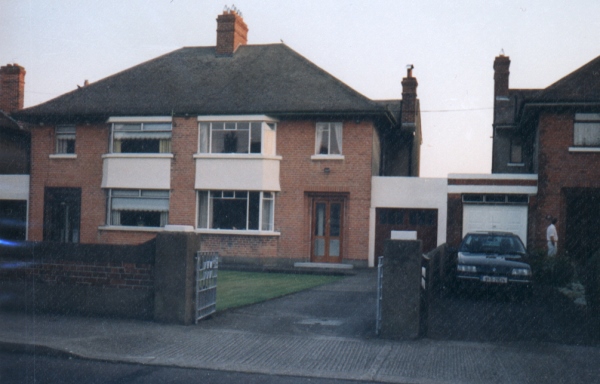
Vincent and Nora started out in Blackheath Park where they bought a house (No. 17). I think the price they paid for it was around £ 600. Their next door neighbour was Vincent McLaughlin, who, with his wife Maura began a friendship with my parents that was to last a lifetime. They had looked at houses in Bushy Park, but preferred [the more expensive] houses in Blackheath, which had just been built. The moved in there after getting married in 1939.
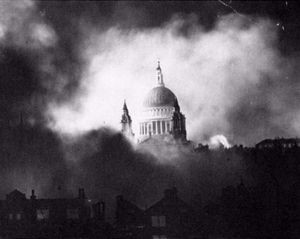
In January 1940, as the German war machine prepared to invade the West European countries, their first son, Tony was born.
On the 2nd of January 1941 the first German bombs fell on Terenure, and South Circular Road was bombed on the 3rd. Just over two weeks later, Pat was born. A few months later on 31 May, the North Strand was bombed with the loss of 28 lives. My mother was at home on that night, while my dad worked down on the North Wall (Dublin Port). The bombs fell very close to where her cousin, Hannah Shelley lived.
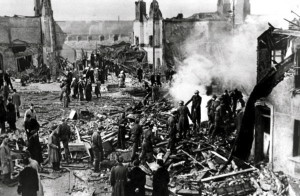
Life moved on in Blackheath Park, with the War rumbling on around them.
Tony says he saw a Messerschmidt and Spitfire dog-fighting over the houses. Money was a problem then – more due to extravagance on Nora’s part and poor money management. They had no clue, either of them how to run a house. Like most young married couples.
In December 1944, Nora was pregnant again. In August 1945, two weeks after the Atom Bomb (Fat Boy) was dropped on Nagasaki, Derek and Denise were born in Nurse Drum’s nursing home on Vernon Avenue. (Just a block up from the Clontarf Road.) Things became busy then with a five year old and four year old and twins to look after.
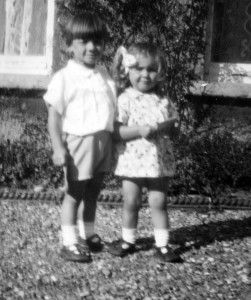
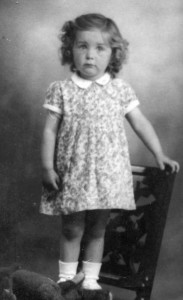
The photo of Pat was taken around this time. In the next room, Bernie Slattery was having her first child, Bride (Donie), and as a result of that meeting, Bernie and her husband Thomas (Thos) also became lifelong friends of my parents. This is the only photo of Pat I have ever seen, where she is not laughing!
Then on 22nd November 1945, tragedy struck. Gastroenteritis was prevalent in the area, and Denise came down with it. Dr. Lappin told my mother there was nothing that could be done, and true enough, within 24 hours she passed away. Vincent and our neighbour, Vin McLaughlin, took her to Glasnevin, where she was buried in the plot of “The Little Angels”. She was three months old. Nora was left at home, grieving and looking after the other three children. It was to be 50 years before she was ever to see the grave.
I can just remember a few things about living there… the piano my mother bought being brought in to the house on a very icy day, the movers had to put sacks on the ground. As a little guy of about four years old, I couldn’t stand on the ground at all – it was too slippery. Tony and Pat were probably at school that day. The photo is of Pat, taken around that time.
Vincent would often go up the country to border posts, to relieve his colleagues for holidays etc. I can remember seeing him off one time at Dublin Airport (Collinstown) flying out in a Dakota DC3. He must have been going to Shannon then. We were standing on the balcony waving to him, and my mum was ogling the pilots, “oooh look at those pilots in their lovely nylon shirts.” One of my earliest memories.
It was in Blackheath Park that my parents made a lifelong friendship with the next door neighbors, Vin and Maura McLaughlin. They were two wonderful people, and were probably the best friends they ever had, outside of family.
We all went to school in Belgrove. (We little realized that our little sister Ann would end up marrying the son of the Headmaster, Mr. Kelleher [who we despised!]) But that’s jumping ahead a bit. In 1950 the financial situation got a bit grim. Their financial management skills were almost non-existent in those days. Like most of us, they learned the hard way. In the heel of the hunt, they had to sell the house and downsize. I don’t remember much about the process that led up to it, but I imagine they must have done a good bit of looking around, and eventually they came up with a new development in a place called Hollybrook Grove. This was definitely a step down for my mother in particular, as she was used to the ‘good life’ at Strandville, and was used to living in a good middle class neighborhood. Hollybrook Grove wasn’t quite, umm, the same level.
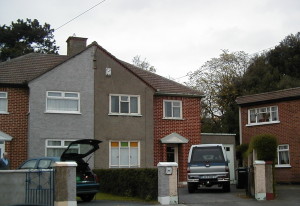
coincidentally, my cell phone number ends in 6162, the numbers of the two semi-detached houses.
The house was a small 3 bedroom with one bathroom. It was fine for a small family, but even with three children, it was a tight squeeze. One of the rooms was the ‘box-room’ which had a large box where the stairs passed underneath. This was my room, and I was perfectly happy there. The problem of who to put where was solved by shipping Tony out to Strandville to live with my Grandfather to “keep him company”. This need for company was partly true, as my granda had been recently widowed when my grandmother died after a massive stroke – this would have been about 1949 or 1950.
All this worked fine until 1951, when my mother got pregnant again. She had twins – Ann and Noreen, who were almost Leap Year twins, which would have been a considerable status thing. They were born on 28th February 1952. I remember when they were brought home, they were tiny, and she put them in the deep drawers of her dressing table, padded with pillows! But this wouldn’t work forever.
When we were in 62 Hollybrook Grove, Dada was planning to do some maintenance on the gutters of the two-story house. He made his own ladder, from two long 4×2 timbers, and 2×1 steps, which were nailed to the uprights. The ladder was on grass when he went up on it, and it slipped. He had a horrible fall from it, his legs going through a window, and was bedridden for quite a time. This would have been around 1955. It seems to me that it wasn’t long after that when he experienced circulation problems in his feet. Then he developed gangrene in one foot. If I’m right about the date, 1955, he would have been 61 at the time.
The solution for the gangrene was to amputate his toe. This didn’t work, and in the end, his leg was amputated above the knee. He was fitted with a prosthetic leg. However, my understanding is that the operation to remove the leg was somehow done badly, and he was in continuous pain from it. As a result, it was difficult to wear the artificial leg. This is my memory of him in later years; bedridden a lot, in pain a lot of the time, going to the chemist to get codeine, which he seemed to need continuously. He did have good times too, taking the family out for drives in Tony’s car. (Dada never did own his own car – at least since he got married.)
Still, they kept looking for a new house. On Saturdays they would go out for drives with Uncle Vin (McLaughlin), and I think a lot of these trips were spent looking at areas that we could move into,.
The outcome was that we bought and moved into a house in Dollymount; 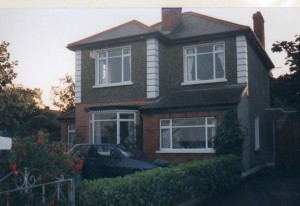 374 Clontarf Road, in 1957. The house even had a name – St. Gerards. This was a big step up. The back garden was huge – no one thought about how my dad would look after it, but he did manage for quite a long time. It was a fine house and still is. There we settled down in happy middle class comfort. Where the money came from to buy the house is still a mystery, that wasn’t revealed to me on that drive home from San Antonio.
374 Clontarf Road, in 1957. The house even had a name – St. Gerards. This was a big step up. The back garden was huge – no one thought about how my dad would look after it, but he did manage for quite a long time. It was a fine house and still is. There we settled down in happy middle class comfort. Where the money came from to buy the house is still a mystery, that wasn’t revealed to me on that drive home from San Antonio.
But things got more difficult for my dad. He tried going back to work, but that didn’t last long, and he was bedridden again. In the end he had to take early retirement, on a reduced pension. There were always money problems. Mama’s life seemed to be spent between keeping the house during the day and going up to the Mater Hospital at night. Uncle Vin drove her up there almost every night, which when I look back on it, was a remarkable act of friendship. This went on for years.
The financial situation got tighter and tighter. Each of us three older kids was working, though I was still going to school, and working at night in a cinema. Mother took all my wages. Later I got a job in a hotel in Monkstown, near Dunleary and finally ended up working as a waiter in the Royal Dublin Golf Club.
Pat meantime got a job as a Rail Hostess – an idea C.I.E. were trying out, and later
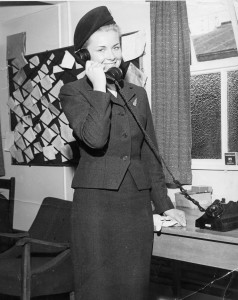
discontinued.) After that, she got taken on by Aer Lingus as an air hostess, and spent many years there. About 1963, she came over to visit me when my ship arrived in Bristol to discharge. She told me she’d met this really nice guy (from Bristol) who was a former Royal Navy pilot. His name was John, and she really fancied him. That relationship blossomed and finally in 1963? they were married. John had lived in a little cottage on Strand Road in Sutton, which was too small, so they moved into the upstairs of No. 374. That was a very temporary move, and they later moved to a bungalow in Kilbarrack where Tanya was born.
Meanwhile Tony got married to Patsy (Taplin) and joined the Dublin Fire Brigade, where he rose through the ranks until his retirement in 2005, as a District Officer.
During this period, 1960 – 1970 they decided to turn the house into a Bed and Breakfast to bring in some extra revenue. This involved some renovations to the downstairs bathroom, but nothing like you would have to do nowadays. The guests started coming in and I kind of think my mom enjoyed it. She made lot of friends and many came back for return visits. At this stage, Pat was working in Aer Lingus, Tony had got married and joined the Fire Service, and I had gone away to sea. So all our rooms were rented out, except Pat and the twins. Ann and Noreen shared a room and Pat had her own small room on the middle landing over the garage.
In the end, my mother had to take a job herself, working in a local shop behind the counter. She would have been about 50 at the time, with two children in school, and an ailing husband, and probably still running the guest house, but she did it.
Around 1963 Dada and Mama went to Rome with Pat, Ann and Noreen to visit Pat’s then fiancée Carlos. I believe they had a great time there – I was at sea at the time, so only heard about it later.
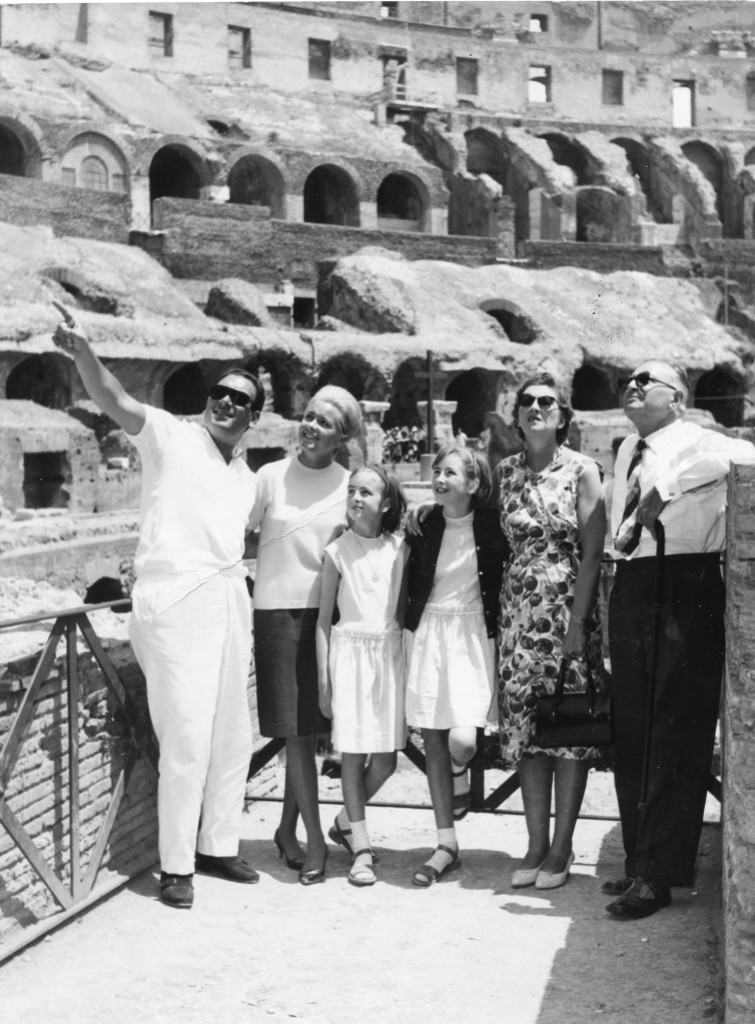
But the house in Dollymount was proving a bit too much for them – Dada couldn’t cope with the big back garden, and couldn’t manage the stairs any more. In 1970 they finally sold it, and moved to a bungalow in Kilbarrack. But I think my father’s heart stayed in the lovely house on Clontarf Road, with it’s magnificent views of the Bull Island and Howth Head; it’s lovely gardens and conservatory, where he liked to sit in the sun.
When Terry and I got married in 1969, he was back in hospital – in the Mater, so he was unable to be at our wedding. I don’t know what the problem was, but he was pretty ill. We went up to see him after the reception. Terry and I spent a year and a half at sea together, on the Supertanker, Evgenia Chandris. I had aspirations to study, so after that we moved to Plymouth, where I started my studies for a BSc. Degree. all this time, Dada’s health was deteriorating. It wasn’t all bad. My mother said she enjoyed that time together; their finances were a bit better, and they used to have long chats together over a glass of sherry.
In January 1971, I got a call to go home, as Dada was seriously ill. He was in St. Joseph’s Nursing Home in Raheny. (I can still remember the occasion, the Nuclear Engineering Professor came over to me during class, and whispered that I was needed at home.)
For a few days, Dada was really bad, but then seemed to make a recovery. We were all delighted, but I overheard the doctor saying to my mother that he was terminal. That was the first time I’d ever heard that expression. I went back to my studies, but a week later, I got another call to return home. I just managed to see him, and say goodbye. He died shortly after. The date was January 27, 1971.
It was doubly hard on my mother, because her father had passed away a week earlier. But she was pretty stoic about it; looking back, she had a tough life during those years.
In 1971 he passed away, from heart failure, brought on by the continuous suffering from the leg and of course, the smoking. But they didn’t know much about the dangers of the oul’ fag then.
Following his death, my mother moved to a Sutton Park to a rental house, and eventually bought a house on Balkill Park in Howth, where she lived until about the 1980’s.
Eventually, she complained more and more about the rigors of walking up the steep hill, and any other reason she could think of, and decided to sell the house. This was against the advice of just about everyone, because it was such a patently bad economic move. But nothing would stop her, and she sold. The next move (6th – if you’ve been keeping count) was down to the village to a flat on Thornamby Road. This was the rear portion of a bungalow, and she had a nice back garden. The front was a doctor’s surgery, so she didn’t have to go far to meet her medical needs. It was a lovely situation, near the shops, with the church just across the road, and lovely walks around by the cliffs of Howth and the harbor. Tony was only just up the road, and Ann wasn’t too far away either. In a lot of ways, it was more cosy than the house up on Balkill.
She stayed there until about 1987. Things had become a little difficult because of the surgery; apparently, there were a number of break-ins – druggies looking for drugs. She felt uncomfortable with this and move no. 7 was to Sutton Cross, on the main road. This was not nearly so nice a place, but she made the most of it, and stayed there until the landlord decided to sell the property. This time, it was left to the family to find another place, (Tony and Pat mostly) and she ended up in a lovely new little townhouse in the grounds of Clontarf Castle. Again, it was convenient to shops – not so much to church, but there were nice walks around the area, and the community was gated. It was central to the homes of her kids (except pat and myself) too, and they could visit fairly easily. She became increasingly dependent on these visits. Her health gradually deteriorated, though she gave up smoking. She did walk a fair bit, but as her legs got worse that gradually stopped. Ann knew a Latvian woman named Lydia, who used to come in and look after her, and eventually moved in. She developed a good relationship with my mother.
The 9th and final move was to St. Gabriel’s nursing home in Harmonstown. She died there in 2005 aged 90.
Children
Tony (b. Jan 25 1940)
Patricia (b. Jan 19 1941)
Denice Marie (b. Aug. 22 1945 – Nov. 22 1945)
Derek (b. Aug. 22 1945)
Anne (b. Feb. 28 1952)
Noreen (b. Feb. 28 1952)